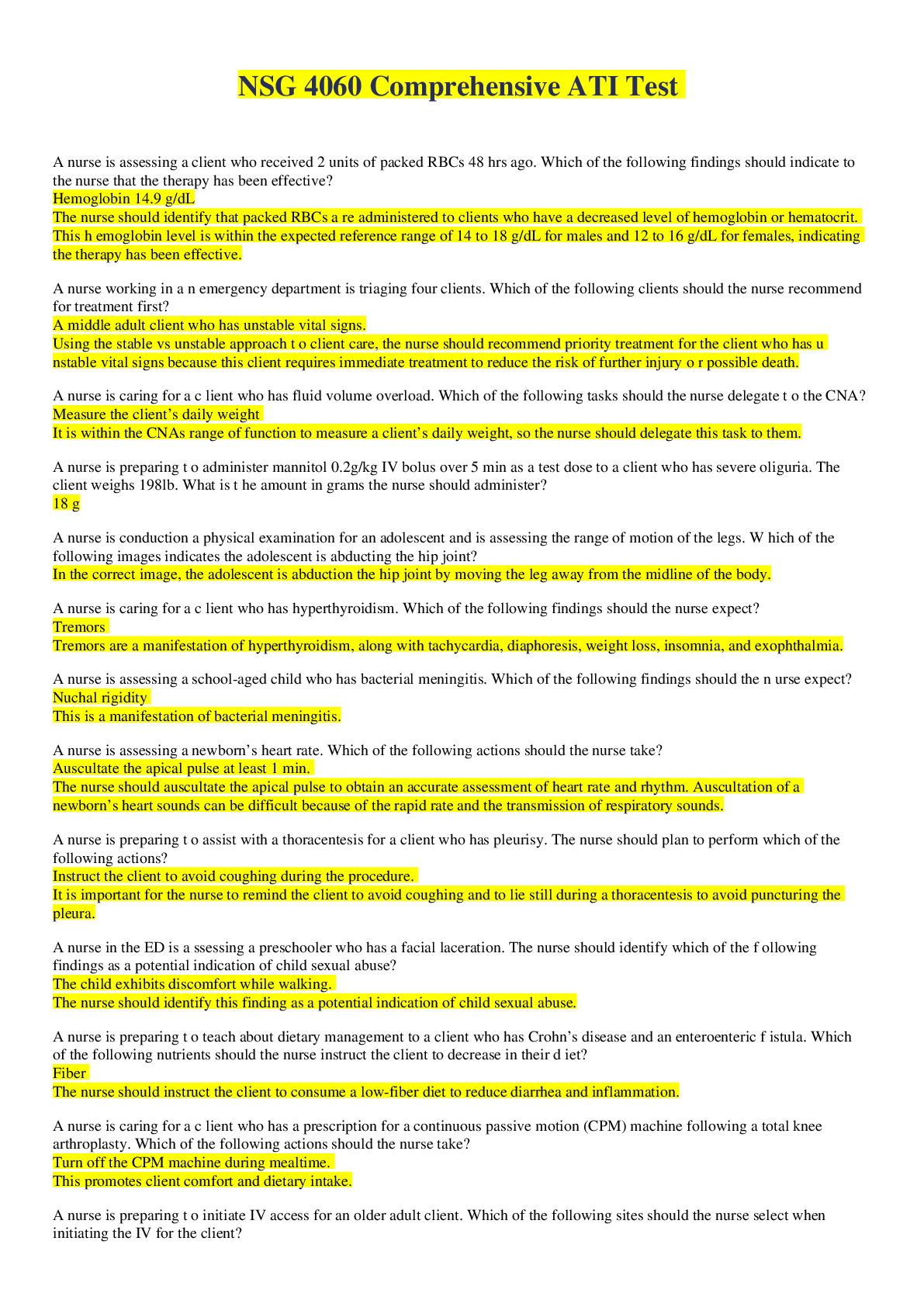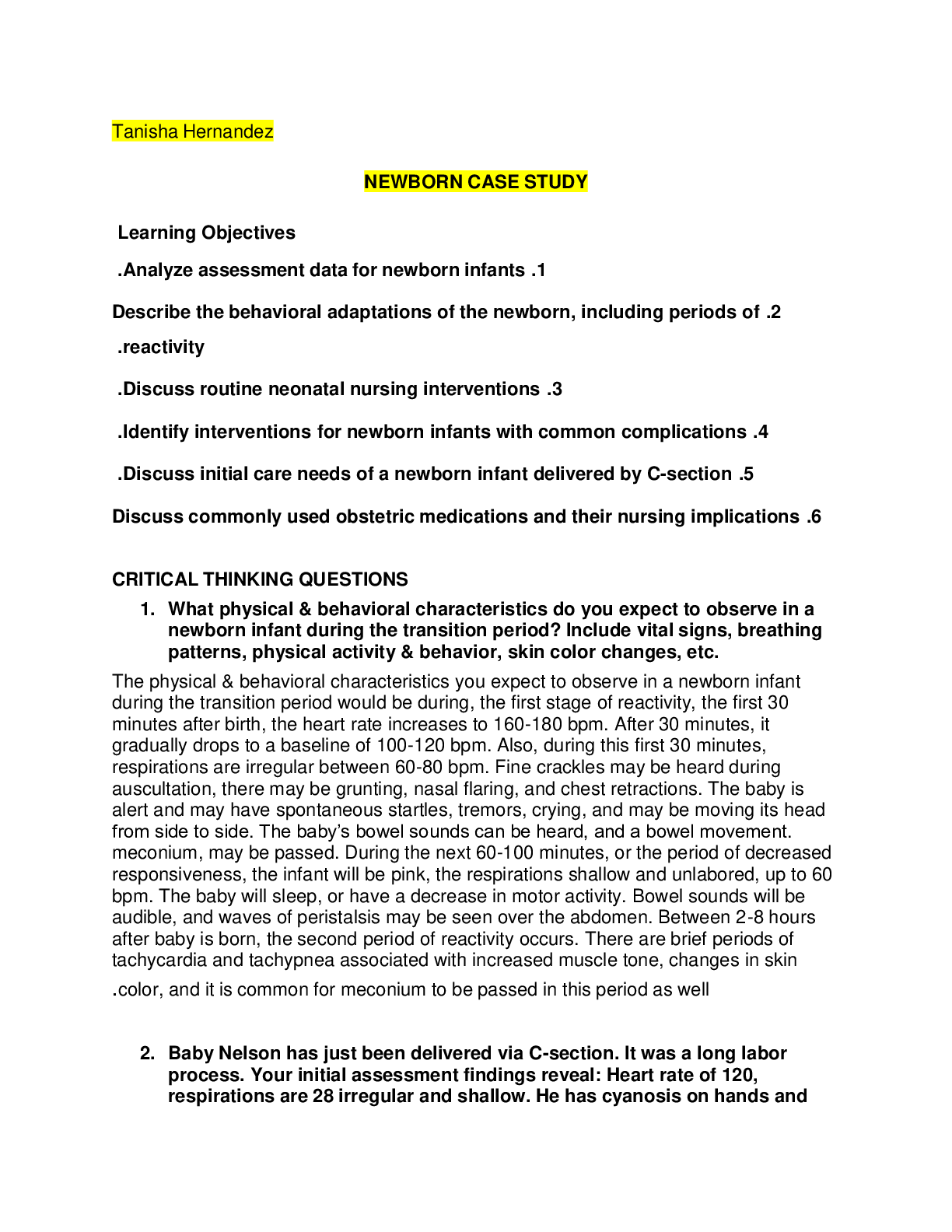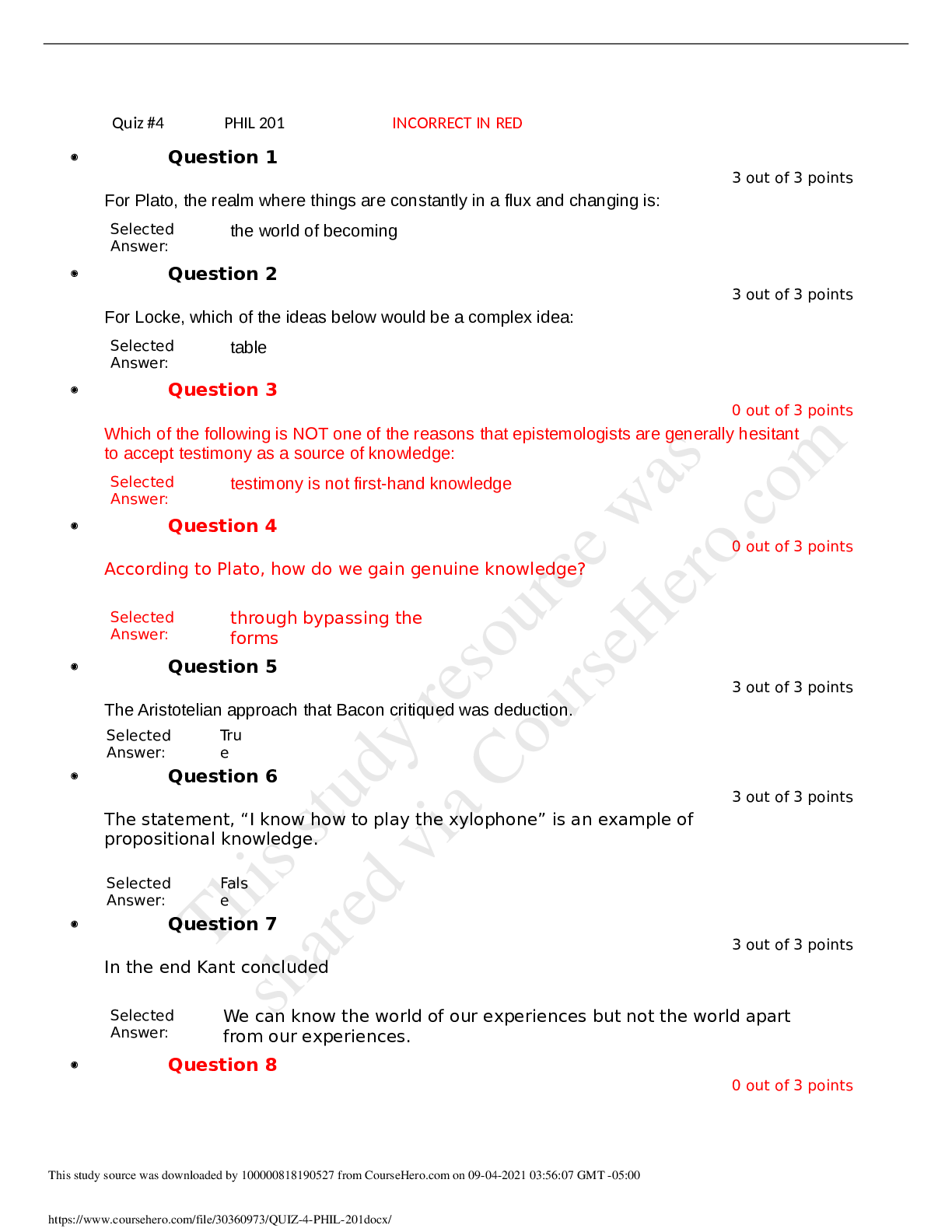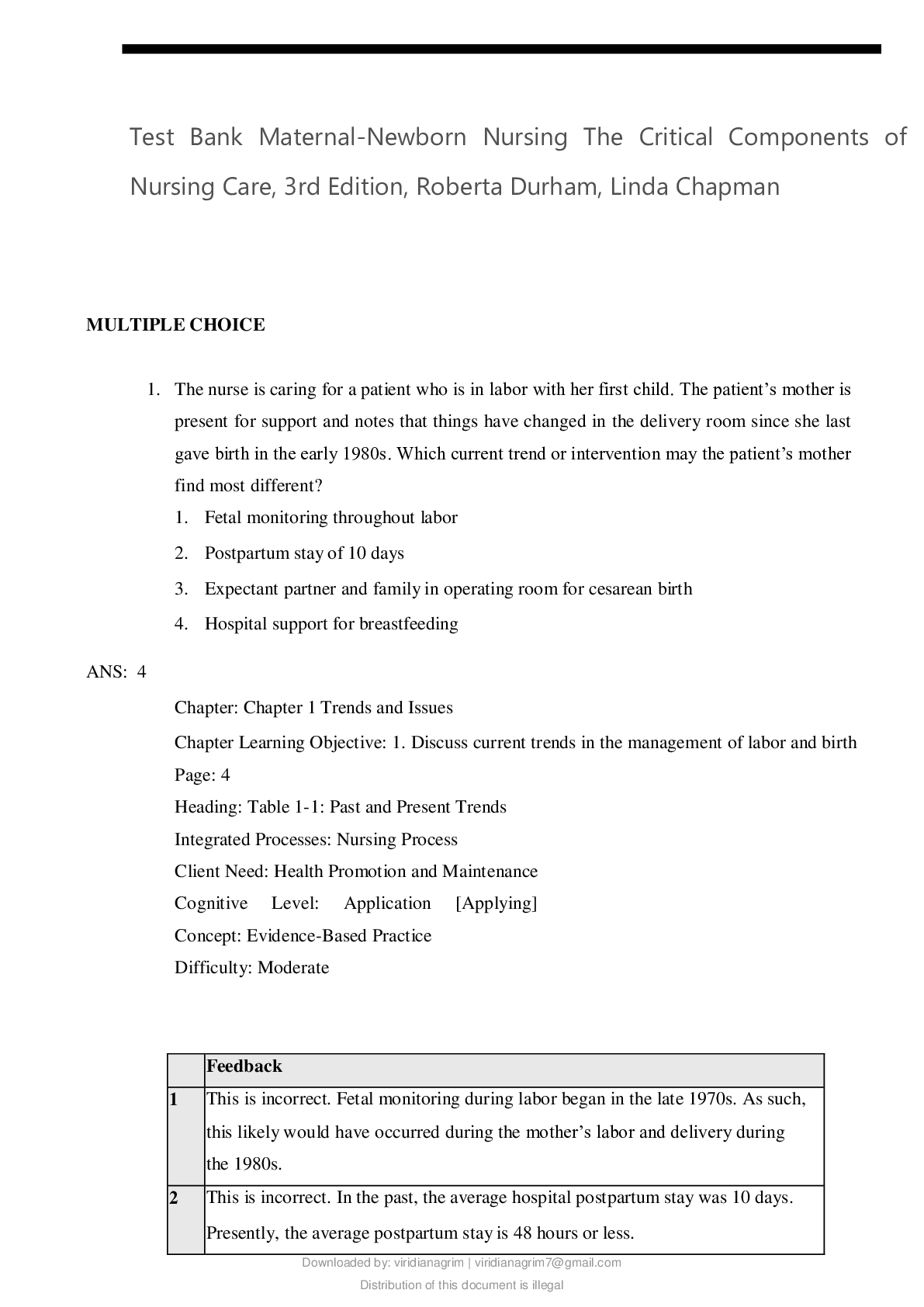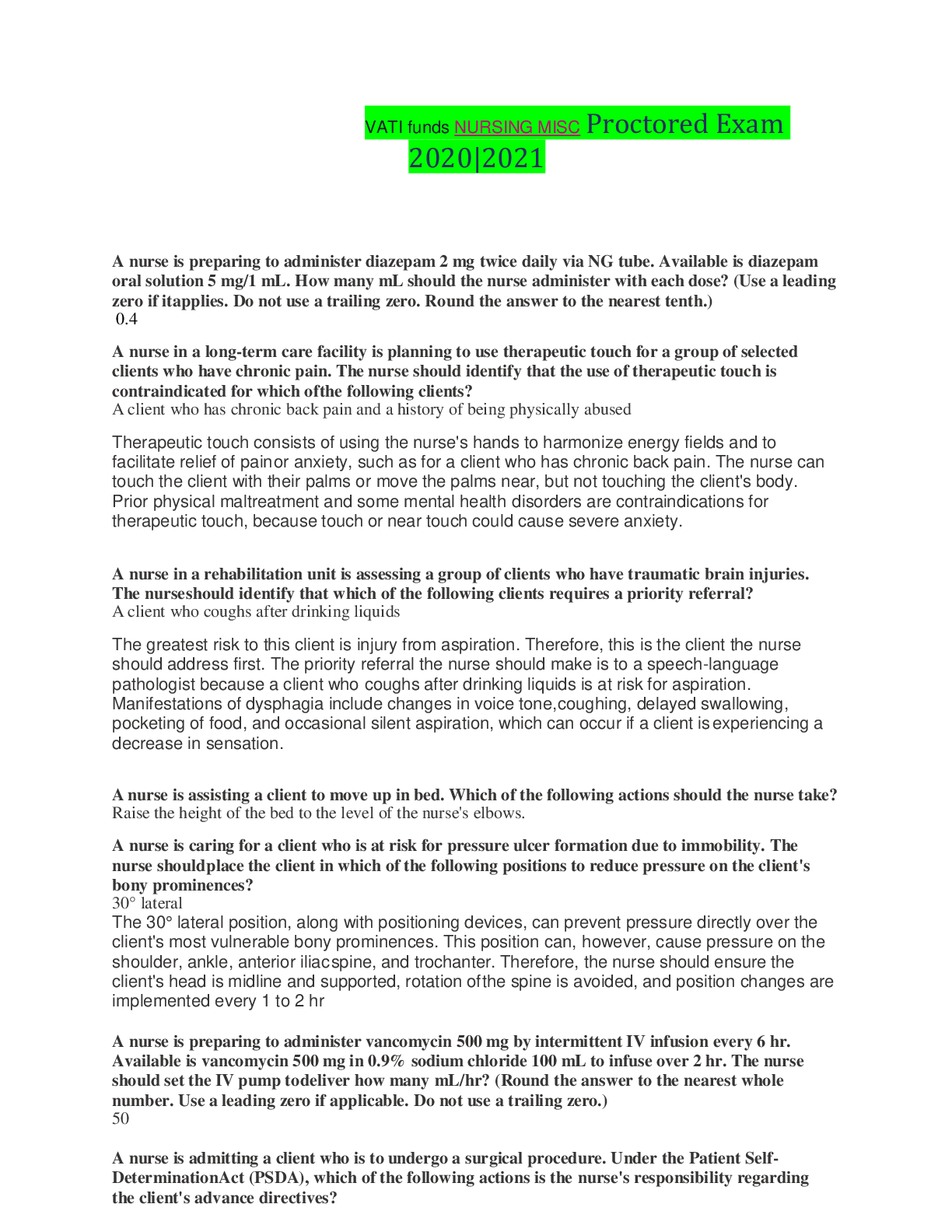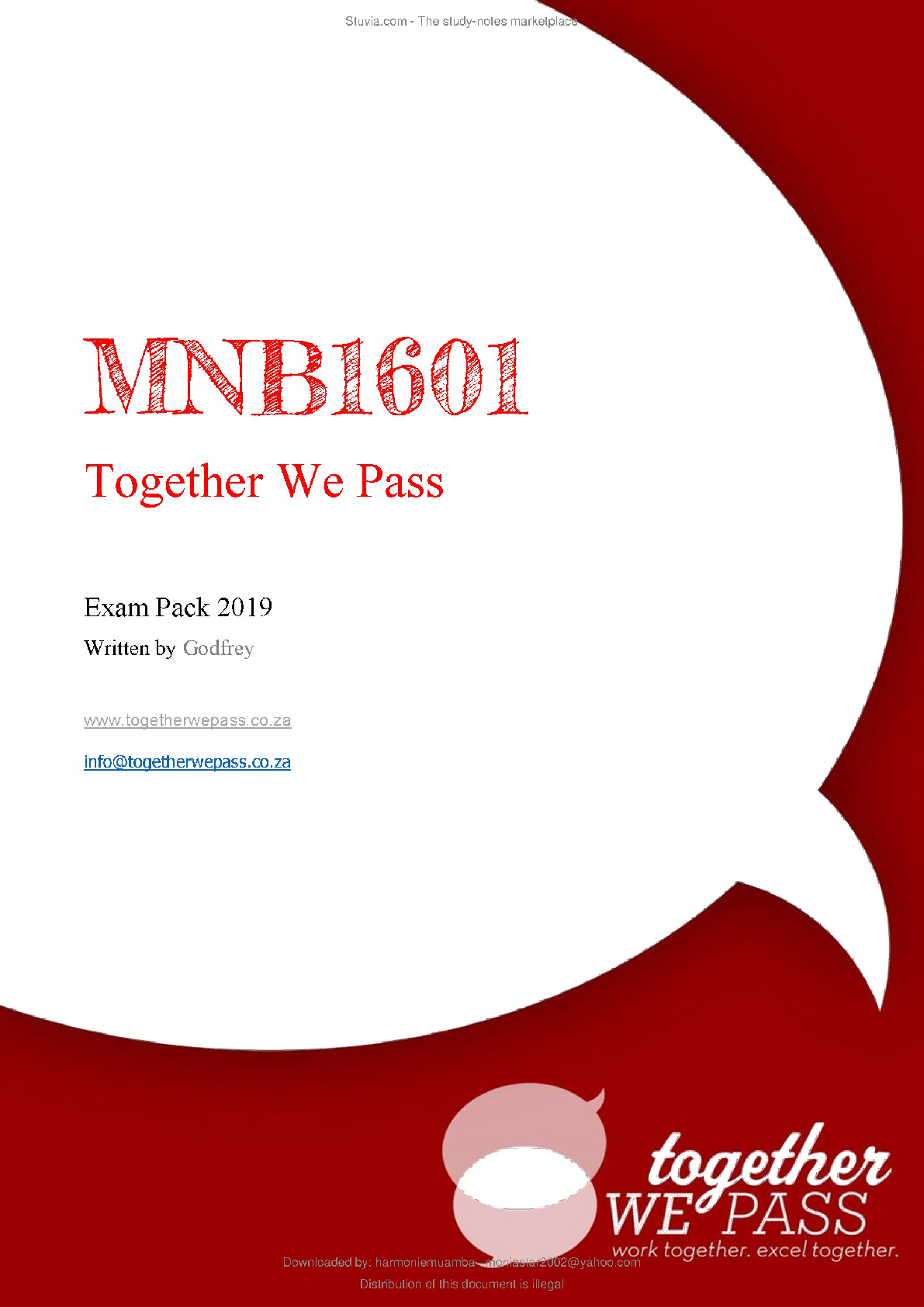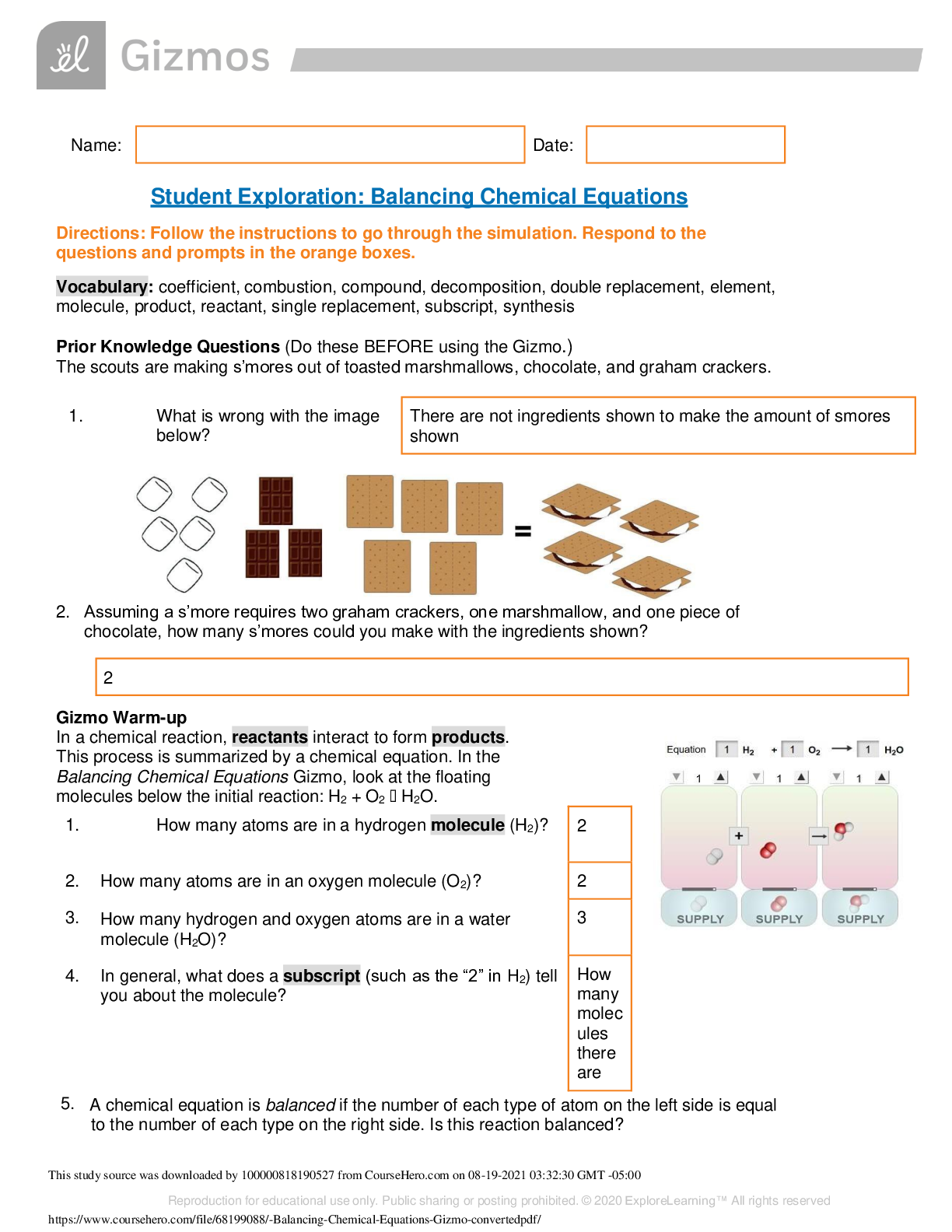*NURSING > CASE STUDY > NUR160 WEEK 3, Ch. 11-20 QUIZ / Citrus College -NURSING 160 Quiz 3 Answers (summer 2021) (All)
NUR160 WEEK 3, Ch. 11-20 QUIZ / Citrus College -NURSING 160 Quiz 3 Answers (summer 2021)
Document Content and Description Below
WEEK 3, Ch. 11-20 QUIZ 1. An older resident in a long-term care facility reports to the nurse that she has been noticing changes in her vision, including the appearance of halos around objects & a yel... low tint to most objects. The nurse knows that these complaints are most often associated with: a. Glaucoma b. Diabetic retinopathy c. Cataracts d. Age-related macular degeneration 2. A nurse is educating an older patient is Dx with diabetic retinopathy on ways to slow the progression of the disease. The nurse identifies a need for further instruction when the patient states: a. Eating a diet high in beta-carotene can stop disease progression b. Strict control of blood glucose levels is important in slowing disease progression c. Control of BP & cholesterol levels are important steps slowing disease progression d. Laser photocoagulation treatments can stop progression of the disease e. Wearing sunglasses to protect the eyes from UV light can stop disease progression 3. An older nursing home resident reports that her hearing loss is getting worse. What is the first action of the nurse? a. Teach the resident to read lips b. Refer the resident for an evaluation for a hearing aid c. Raise her voice when speaking to the resident d. Examine the resident’s ears for cerumen impaction 4. A nurse is assessing an older patient who complains of pruritus. The nurse suggests which of the following interventions to alleviate the complaint? a. Use only non-perfumed laundry detergent b. Avoid sudden temperature changes c. Wear loose-fitting clothing d. Apply heat to affected areas e. Exercise vigorously for at least 30 mins daily 5. A nurse is educating a group of nursing assistants in long-term care on the prevention of skin tears. Which of the comments below indicates a need for further education? a. Lubricate the resident’s skin with moisturizers twice daily b. Ensure that the resident has adequate nutrition & hydration c. Bathe the resident in hot soapy water d. Avoid the use of lifting devices when transferring the residents e. Dress the resident in long sleeves & long pants 6. Which of the following is NOT a subscale on the Braden Scale for predicting pressure ulcers? a. Mobility b. Nutrition c. Moisture d. Age 7. A nursing student asks the instructor, “Our textbook discussed the obesity paradox in older adults. I am not sure I understand; isn’t obesity bad for everyone?” The best response by the instructor is: a. “Obesity is not a concern in older adults, as most older people tend to weigh less than they did when they were younger.” b. “Obesity is a concern in all age groups; however, over the past decade obesity in older adults has decreased.” c. “Obesity in older adults is less of a concern than we once thought; individuals over age 65 with a higher BMI have a lower mortality rate.” d. “While there is evidence that obesity in younger people lessens life expectancy, it remains unclear whether overweight & obesity are predictors of mortality in older adults.” 8. Many older adults have a vitamin B12 deficiency. Reasons for this include which of the following? a. Normal age-related changes in the stomach include a lower production of gastric acid making vitamin B12 absorption less efficient. b. A major source of B12 is sunlight & older adults are less likely to be outdoors c. Most older adults do not consume five servings of fruits & vegetables daily, which is the main dietary source of vitamin B12 d. Most elders are not concerned about their dietary intake leading to malnutrition & lack of B12. 9. A nurse is performing an admission assessment on an older patient who presented with a high fever & cough, reduced oral intake for 3 days, & lower extremity weakness. The patient has sunken eyes, & the patient’s skin turgor over the sternum is poor. The nurse suspects that the patient is dehydrated. Which of the following are indicators of dehydration in this patient? a. Poor skin turgor over the sternum b. High fever c. Sunken eyes d. Cough 10. A nurse in a long-term care facility notes that an older resident with Alzheimer’s disease awakens frequently at night & is restless & agitated. Which of the following interventions will be most effective to help manage this resident’s sleep problems? a. Limiting fluid intake for the resident b. Administering a mild sedative hypnotic at bedtime c. Taking the resident outside in the garden for 45 minutes daily d. Educating the resident on the association between Alzheimer’s Disease & insomnia 11. A long-term care facility has selected sleep promotion as its quality improvement project. Which of the following interventions would NOT be appropriate to implement on this unit? a. Limiting caffeine & fluids before bedtime b. Ensuring that all residents receive evening care & are in bed by 8 PM c. Taking as many residents as possible outside for 30 minutes daily d. Avoiding waking residents for routine care during the night 12. The nurse is discussing physical activity w/ an older client. Which of the following is the best recommendation? a. “You need to engage in 30 minutes of moderate intensity exercise on at least 5 days a week.” b. “There are no specific recommendations for someone of your age; just keep moving.” c. “You need to engage in at least 30 minutes of moderate intensity exercise every day of the week.” d. “Since you are 75, the recommendations are 30 minutes of moderate exercise three times a week.” 13. A 90 Y/O woman is admitted to the hospital with a Dx of pneumonia. She has a Hx of HTN & CHF & is on a total of 5 different medications for these chronic conditions. The nurse caring for the woman develops a care plan that includes the Dx: Risk for falls in relation to: a. Being admitted to a long-term care facility b. Presence of comorbidities & polypharmacy c. New Dx of pneumonia leading to lack of O2 d. The client’s dietary intake for calcium adequacy. 14. A home health nurse is making a home visit to an older patient. A nurse conducts a home safety assessment & screens the environment for potential hazards for falls. Which of the following are ways to prevent falls in the home? a. There are no railings on the stairway b. Night-lights in all rooms c. A small throw rug outside of the shower stall d. Grab bars in bathroom beside toilet 15. A nurse is discussing oral care with assistive personnel. Which of the following would be included in the plan? a. Lemon glycerin swabs are the best option for oral care b. Lemon glycerin swabs should not be used for oral care c. Lemon glycerin swabs are safe to be used for the elderly d. Lemon glycerin swabs should be used for better oral care 16. Which of the following is accurate in regard to “The Joint Commission Guidelines for Dietary assessment?” a. Assess for pt’s religious or personal restrictions in relation to their diet b. Assess for pt’s likes & dislikes to accommodate for maximum intake c. Assess family’s ability to provide food to ensure familiar food is served d. Assess for family support if the pt will be served food at the hospital 17. Dehydration among elderly is a prevalent problem. If not treated adequately, mortality rate can be as high as 50%. Risk factors leading to dehydration for elderly include: a. Diminished sense of thirst & the decrease in total body water b. Diminished sense of thirst & lack of subcutaneous layer of the skin c. Decreased kidney function & lack of water intake d. Decreased water absorption & altered memory 18. Nonpharmacological interventions for constipation are many. Which of the following is not an intervention for constipation? a. Increase in fluid & fiber intake b. Increase physical activity c. Position: sitting or squatting d. Position: lateral or supine 19. Circadian rhythm sleep disorders are when a. Normal sleep occurs at abnormal times b. Sleep pattern is switched around c. Normal sleep occurs at different times d. Sleep patterns are not predictable 20. Function focused care (FCC) is a comprehensive system level approach that prioritizes… a. Preservation & restoration of functional capacity b. Prevention & reversal of functional capacity c. Prevention & rehabilitation of functional capacity d. Preservation & rehabilitation of functional capacity. [Show More]
Last updated: 1 year ago
Preview 1 out of 4 pages
Instant download

Buy this document to get the full access instantly
Instant Download Access after purchase
Add to cartInstant download
Reviews( 0 )
Document information
Connected school, study & course
About the document
Uploaded On
Aug 19, 2021
Number of pages
4
Written in
Additional information
This document has been written for:
Uploaded
Aug 19, 2021
Downloads
0
Views
24


